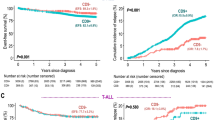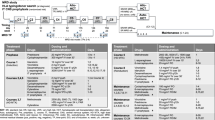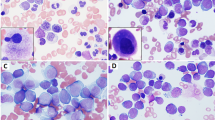Abstract
The immunologic features of leukemic cells at the time of 1st hematologic relapse were compared to those obtained at initial diagnosis in 128 patients (69 children and 59 adults) with acute lymphoblastic leukemia (ALL) treated at a single institution. An immunophenotypic change was observed in 59 cases (46%), more frequently in T (20/25) than in B (39/103) lineage ALL (80 vs 38%, P = 0.0008), but with a similar incidence in adults and children. Of these cases, 34 (24 B- and 10 T-ALL) changed at relapse their intralineage subgroup affiliation, although no complete shift from B to T lineage ALL, or vice versa, was observed. The myeloid antigens CD13 and/or CD33 were frequently lost (2/5 cases) or acquired (12/123 cases) at relapse. In 21 cases, the immunophenotype at relapse was more undifferentiated than at diagnosis, while it was more differentiated in 13 cases. Initial treatment intensity or preceding treatment with teniposide did not affect the phenotypic profile at relapse. Complete response (CR) rate to salvage therapy and event-free survival were not influenced by the immunophenotypic shifts, nor by the presence, at relapse, of leukemic cells expressing the myeloid antigens CD13 and/or CD33. Univariate analysis suggested that prognosis after relapse was dependent on the duration of 1st CR, patients’ age and immunophenotype at the time of diagnosis, with a worse outcome for patients with T lineage ALL and for patients with the less differentiated subgroup of B lineage ALL (CD19+ and CD10−). Multivariate analysis showed that only two factors, duration of 1st CR and grade of immunologic differentiation at diagnosis, have independent prognostic value in relapsed ALL.
This is a preview of subscription content, access via your institution
Access options
Subscribe to this journal
Receive 12 print issues and online access
$259.00 per year
only $21.58 per issue
Buy this article
- Purchase on Springer Link
- Instant access to full article PDF
Prices may be subject to local taxes which are calculated during checkout
Similar content being viewed by others
Author information
Authors and Affiliations
Rights and permissions
About this article
Cite this article
Guglielmi, C., Cordone, I., Boecklin, F. et al. Immunophenotype of adult and childhood acute lymphoblastic leukemia: changes at first relapse and clinico-prognostic implications. Leukemia 11, 1501–1507 (1997). https://doi.org/10.1038/sj.leu.2400772
Received:
Accepted:
Issue Date:
DOI: https://doi.org/10.1038/sj.leu.2400772
Keywords
This article is cited by
-
CD7 aberrant expression led to a lineage switch at relapsed childhood acute pre-B lymphoblastic leukemia
Medical Molecular Morphology (2016)
-
HLA-DPβ1 Asp84-Lys69 antigen-binding signature predicts event-free survival in childhood B-cell precursor acute lymphoblastic leukaemia: results from the MRC UKALL XI childhood ALL trial
Blood Cancer Journal (2012)
-
Combination of chemotherapy and gemtuzumab ozogamicin in adult Philadelphia positive acute lymphoblastic leukemia patient harboring CD33 expression
International Journal of Hematology (2008)
-
Immunologic monitoring in adults with acute lymphoblastic leukemia
Current Oncology Reports (2003)
-
BIOMED-1 concerted action report: flow cytometric immunophenotyping of precursor B-ALL with standardized triple-stainings
Leukemia (2001)



